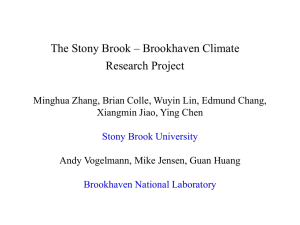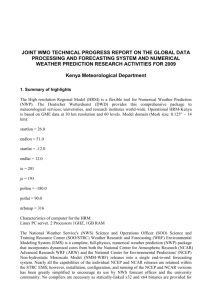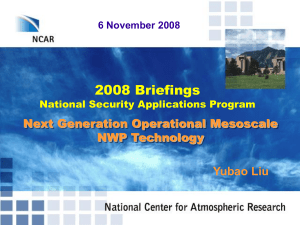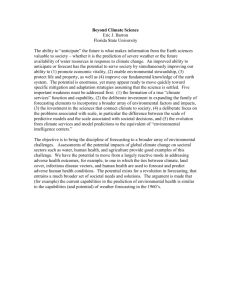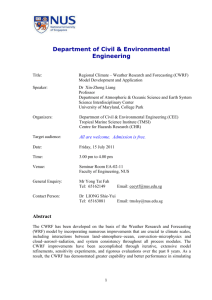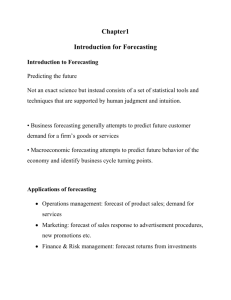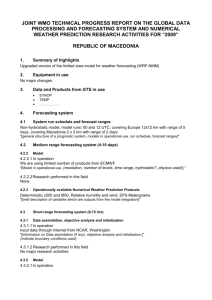2008_Singapore
advertisement
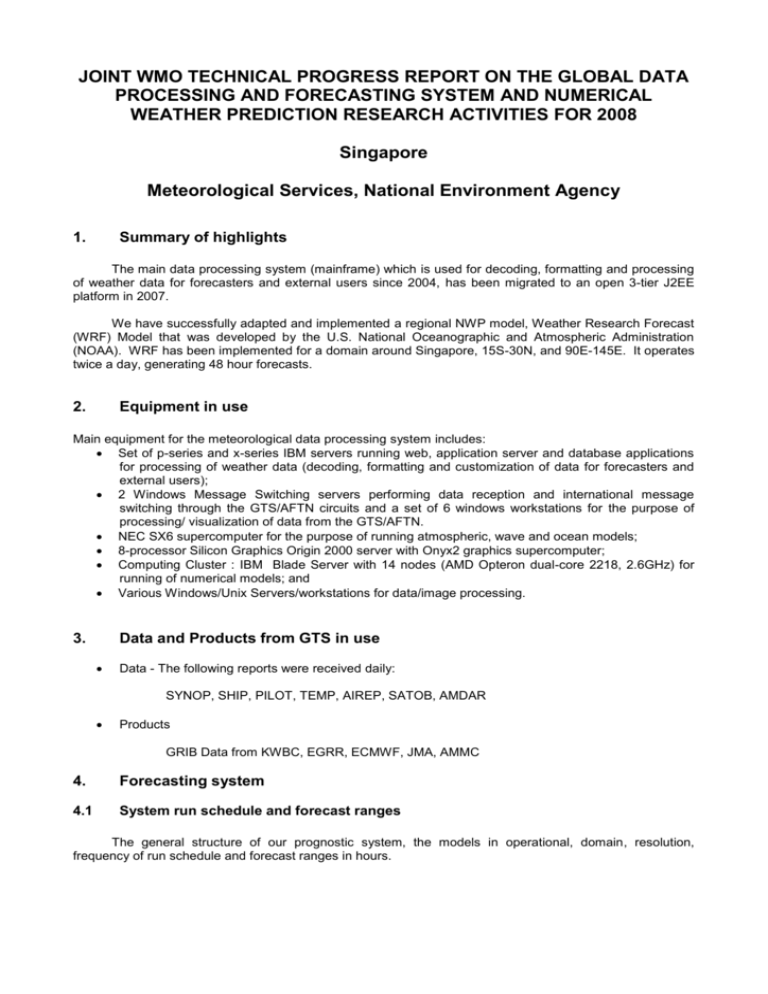
JOINT WMO TECHNICAL PROGRESS REPORT ON THE GLOBAL DATA PROCESSING AND FORECASTING SYSTEM AND NUMERICAL WEATHER PREDICTION RESEARCH ACTIVITIES FOR 2008 Singapore Meteorological Services, National Environment Agency 1. Summary of highlights The main data processing system (mainframe) which is used for decoding, formatting and processing of weather data for forecasters and external users since 2004, has been migrated to an open 3-tier J2EE platform in 2007. We have successfully adapted and implemented a regional NWP model, Weather Research Forecast (WRF) Model that was developed by the U.S. National Oceanographic and Atmospheric Administration (NOAA). WRF has been implemented for a domain around Singapore, 15S-30N, and 90E-145E. It operates twice a day, generating 48 hour forecasts. 2. Equipment in use Main equipment for the meteorological data processing system includes: Set of p-series and x-series IBM servers running web, application server and database applications for processing of weather data (decoding, formatting and customization of data for forecasters and external users); 2 Windows Message Switching servers performing data reception and international message switching through the GTS/AFTN circuits and a set of 6 windows workstations for the purpose of processing/ visualization of data from the GTS/AFTN. NEC SX6 supercomputer for the purpose of running atmospheric, wave and ocean models; 8-processor Silicon Graphics Origin 2000 server with Onyx2 graphics supercomputer; Computing Cluster : IBM Blade Server with 14 nodes (AMD Opteron dual-core 2218, 2.6GHz) for running of numerical models; and Various Windows/Unix Servers/workstations for data/image processing. 3. Data and Products from GTS in use Data - The following reports were received daily: SYNOP, SHIP, PILOT, TEMP, AIREP, SATOB, AMDAR Products GRIB Data from KWBC, EGRR, ECMWF, JMA, AMMC 4. Forecasting system 4.1 System run schedule and forecast ranges The general structure of our prognostic system, the models in operational, domain, resolution, frequency of run schedule and forecast ranges in hours. Model WRF WRF (nest) WaveWatch 3 WAM WAM (nest) Princeton Ocean Model (POM) PRECIS 4.2 Domain 15S-30N, 90E-145E 0.5S-5N, 100.5E106.5E 20S-40N, 60E-160E 50S-50N, 40E-160E 10S-12N, 90E-112E 9S-24N, 99E-121E 13S-26N, 85E-143E Resolution Frequency Forecast 72 h 25km 2 48 h 5km 2 1 deg 1 deg 0.25 deg 1/12 deg 50 km 1 1 1 1 ad-hoc 72 h 48 h 48 h 7 days Medium range forecasting system (4-10 days) No Change. 4.3 Short-range forecasting system (0-72 hrs) We have successfully adapted and implemented a regional NWP model, WRF for short range forecasting. This WRF model at MSD has a regional coverage that is centred over Singapore with a resolution of 25 km and a 3 hourly time step. We are currently experimenting with a high resolution 5km nested run. 4.4 Nowcasting and Very Short-range Forecasting Systems (0-6 hrs) No Change. 4.5 Specialized numerical predictions We have embarked on a long-term climate science study using the regional climate model developed by the U.K. Hadley Centre, known as Providing Regional Climates for Impacts Studies (PRECIS). We run the PRECIS model regionally, under various IPCC scenarios, for Southeast Asia with boundary data provided by the Hadley Centre, to simulate the impact of climate change on temperature, rainfall, humidity and wind in Singapore and the region. 4.6 Extended range forecasts (ERF) (10 days to 30 days) No change. 4.7 Long range forecasts (LRF) (30 days up to two years) 4.7.1 4.7.2 In operation We have adapted and implemented operational statistical seasonal models from the Australia Bureau of Meteorology (BOM), and International Research Institute for Climate and Society (IRI), an internationally renowned climate research organisation under the Earth Institute of the University of Columbia, United States to provide statistical monthly forecasts of both rainfall amount and rain days for Singapore in three months ahead. The models SCOPICS and Climate Prediction Tool (CPT), are from BOM And IRI respectively. 4.7.2 Research performed in this field One of the key outcomes in our research and operational run of these models is the important finding that dissimilar regions of Southeast Asia have varying predictabilities under differing meteorological conditions and in different seasons. For instance, in March-May, there emerges good seasonal predictability skill across northern parts of Southeast Asia, which is a transition season including rainfall onset for some countries. On the other hand, in August-October, there emerges good skill across southern parts of Southeast Asia, again in many parts a transition season including rainfall onset. 5. Verification of prognostic products We have successfully adapted and implemented a regional NWP model, WRF. It is operational since June 2007 and has an average accuracy score of above 70%. 6. Plans for the future (next 4 years) 6.1 Development of the GDPFS 6.1.1 To replace the Message Switching and related visualization systems for the purpose of refresh of obsolete hardware/software, to better handle the migration from TAC to TDCF/BUFR codes and to be able to support the requirements of the Aeronautical Message Handling System. 6.1.2 To replace the supercomputer with a high performance computing cluster. 6.2 Planned research Activities in NWP, Nowcasting and Long-range Forecasting 6.2.1 Planned Research Activities in NWP We have successfully adapted and implemented a regional NWP model, Weather Research Forecast (WRF) Model that was developed by the U.S. National Oceanographic and Atmospheric Administration (NOAA). The current WRF implementation takes as initial and boundary conditions, the model output from NCEP GFS; our planned research activities would include exploring using other global model outputs as initial and boundary conditions for our WRF implementation. 6.2.2 Planned Research Activities in Nowcasting Our existing capabilities provide qualitative forecast of rain for the next 3 hour. Under a new nowcasting project, new forecasting and assessment techniques will be developed to provide continuous forecasting of quantified rainfall amount for local areas within Singapore. This will be done through the assimilation of real-time observation data into mesoscale model WRF. 6.2.3 Planned Research Activities in Long-range Forecasting A research project on multi-model ensemble seasonal prediction modelling is proposed with the aim of pushing the envelope of the existing seasonal prediction capabilities towards quantified confidence and certainty of seasonal prediction based on combining the statistical downscaling of the current operational global climate model outputs. 7. References Information for WRF can be found at http://www.wrf-model.org.
